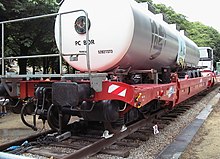Modalohr
Modalohr (also: Lohr Railway System) is a horizontal loading system from the Alsatian Lohr Group for combined rail transport , which enables the handling of semi-trailers and their tractors in parallel on all wagons of a train in special terminals .
Lohr Railway System
The Lohr Railway System consists of the necessary, intrinsic elements of the transshipment terminal and transport wagon, as well as the transshipment process that takes place between them.
Terminals
The transshipment terminal consists of a track embedded in the asphalt with a lifting and rotating device for moving the pockets embedded in the transport wagons at a distance from the carriages. The pockets can be rotated 30 degrees. There are fixed up and down ramps at their ends, which enable loading without any further handling equipment. Different types of terminals can be implemented depending on the space required. Ideally, the transshipment track is long enough to load and unload a block train of around 800 meters at the same time. If there is less space, it can be reduced to the length of a half-train of around 400 meters, with full capacity being available again with two transshipment platforms.
Transport wagons
The 33-meter-long Lohr-UIC transport wagons, which have been in use since 2014, enable the transport of containers with a corner height of up to 426 centimeters thanks to the deep car floor of a maximum of 225 millimeters above the top of the rails. The low-floor wagons are designed as double wagons that are connected to a common bogie . Loads of up to 38 tons can be transported in each of the two transport tubs. This is made possible by the low dead weight of the wagons of at least 40.7 tons. There are three different types of trolleys:
- End car with standard coupling at the outer end and central coupling at the other end (UIC 1),
- Intermediate car with center couplings on both sides (UIC 2) and
- Individual cars with central couplings on both sides (UIC 3).
The wagons (UIC 1) are approved with a maximum payload of 75.6 tonnes for a top speed of 100 km / h and with a payload reduced to 66.6 tonnes for 120 km / h.
The Modalohr system is primarily designed for the transport of non-craneable semi-trailers , which make up the majority of European long-distance truck traffic. In principle, however, it is also possible to use it to transport swap bodies or ISO containers .
Handling process
After the loaded train has entered the terminal and stopped at the intended position, the transport trays are turned by 30 degrees by the turning devices embedded in the track and positioned on the intended ramps. The truck tractors then drive onto the ramps and pull the semi-trailers out of the transport tubs. After the reverse loading process, the transport trays are swiveled back into the track axis and lowered onto the transport wagon with which they are anchored. Then the journey takes place to an appropriately equipped destination terminal, where the procedure is repeated.
According to the manufacturer, the entire transshipment process can be carried out in 15 minutes. However, discharge times of 30 to 60 minutes and charging times of 60 to 90 minutes are more realistic.
Advantages and disadvantages
- advantages
-
- Uncraneable semi-trailers can be loaded.
- The transshipment takes place very quickly compared to crane loading or reach stackers .
- The system works under electrified tracks .
- The tractor and train do not have to be in the terminal at the same time.
- All transport trays can be unloaded in parallel.
- The special transport wagons allow high and heavy semi-trailers to be transported.
- disadvantage
-
- Special terminals (with turning devices in the track and with ramps) are required.
- Large space consumption for the terminals because of the maneuvering and installation areas.
- Because of the small wheels, the freight wagons require more maintenance.
Competing horizontal handling systems
- CargoBeamer
- FlexiWagon
- Mega swing
stretch
Autoroute Ferroviaire Alpine (AFA)
The Autoroute Ferroviaire Alpine has been a 175-kilometer piggyback connection through the Mont-Cenis tunnel between the French Aiton (Savoie) and the Italian Orbassano since November 4, 2003 . Since June 4, 2012, thanks to the Modalohr transport wagons, trucks with a corner height of up to 4 meters can be transported through the tunnel, which is actually only suitable for a corner height of 3.85 meters.
Perpignan - Luxembourg
Since September 2007, up to four pairs of trains have been running on the 1000 kilometer connection between Le Boulou near Perpignan and Bettembourg in Luxembourg . Since January 19, 2012, reinforced trains with 48 parking spaces have been used on this route over a length of 850 meters and a total weight of 2,400 tons.
Perpignan - Calais
A new 1,400-kilometer connection between the port of Calais and Le Boulou was planned for the beginning of 2016 . However, the start of the 680 meter long train, which was planned with 20 transport wagons, was postponed for safety reasons.
Planning
There are numerous plans for further Modalohr connections, including to London , Scandinavia, Smolensk , Istanbul , Trieste and Lisbon , none of which have yet been implemented.
Individual evidence
- ↑ a b c d e Martin Randelhoff: Modalohr - The rolling highway. June 28, 2016, accessed December 30, 2016 .
- ↑ a b c The Lohr System Terminals. Lohr, 2016, accessed on December 30, 2016 (English).
- ^ L'Autoroute Ferroviaire Alpine (AFA). 2016, accessed December 31, 2016 (French).
- ^ France / Calais: la liaison Modalohr Calais-Le Boulou postposée de quelques semaines. Wordpress.com, January 14, 2016, accessed December 31, 2016 (French).
- ^ Projects. Lohr, 2016, accessed on December 31, 2016 (English).

